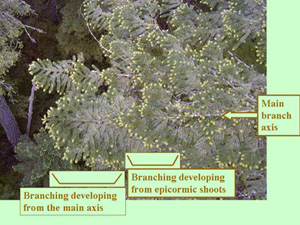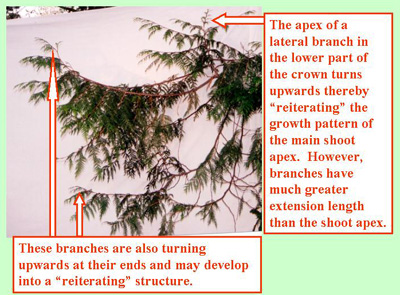Crown development of long-lived trees
We are interested in two species: Pseudotsuga menziesii which
is generally the longest lived species in the Pseudotsuga-Tsuga forest
type, and Thuja plicata which is known to live for over 1200 years.
Here we outline our research into how Pseudotsuga menziesii
manages to live so long, and some aspects of crown development in Thuja
plicata that contribute to its ability to live and growth through shaded
regions of the canopy.
Pseudotsuga menziesii
.
In some forest types plasticity in morphological and physiological
traits of trees is related to the successional status of species. High degrees
of plasticity in morphological traits such as shoot elongation, bifurcation
ratio, and branching pattern may enable some early successional species to survive
into later stages of succession, if they are able to acclimate to changing environmental
conditions and maintain productivity. This is true for Pseudotsuga
menziesii.
Analysis of crown form indicates that old-growth P. menziesii
acclimate to the low-light environment of the late-successional canopy although
the species is a pioneer. P. menziesii have live branches
as low as 15 m off the ground, comparable to large trees of the shade-tolerant
species such as T. heterophylla and A. amabilis. Shoot
production rates and branching patterns are also similar to those of late-successional
species such as A. amabilis and A.grandis that have determinate
growth.
In addition to acclimation, P. menziesii maintains continuous
production of foliage through production of epicormic shoots and branches. Epicormic
shoots arise from dormant buds. When they grow they produce new
foliage bearing shoots where generally none would be expected, i.e., at positions
that are proximal (closer to the trunk) to the current apex. Far
from being a response to damage, as we first thought, epicormic sprouting is
an inherent and repeating process occurring without the stimulus of damage.
So far we have documented three types of epicormic branching in old-growth P.
menziesii.
|
1. Forming generations of foliated shoots
on exisiting branch structures. Epicormic branching
can be recognized by identifying a mis-match of the age of foliage bearing
shoots, or by noting the irregular angle with which a sub-branch arises
along a main branch axis. Analysis of branches cut from
old-growth trees showed that epicormic sub-branch production was a continuing
process, so that epicormic branches form on existing epicormic branches.
In the mid-crown up to 6 'generations' of epicormic development
were found - each layered one upon the previous one.
|

Side view of the end of Douglas fir branchshowing the
development of epicormic branching.

A view down onto a large, mid-canopy, branch of Douglas-fir.
As a branch develops regular branching occurs at its end.
Subsequently epicormic shoots develop from the main axis. This process
is repeated so that "waves" of foliage appear.
|
 2. Development of complex sub-branch
systems. Red arrows show reiteration axes. MS
is the main stem (trunk) of the tree with A1
being a primary branch axis with a reiteration axis, R1,
produced from it and two reiteration axes, R2,
produced from R1. The reiteration
axes can be identified by having markedly smaller diameters than the parent
axis they sprout from and frequently their vertical angle of insertion. Junctions
of epicormic branches with their parent axes often form platform like
structures used as nesting sites by birds, e.g., northern spotted owl.
(Ishii, Ford and Dinnie 2002)
2. Development of complex sub-branch
systems. Red arrows show reiteration axes. MS
is the main stem (trunk) of the tree with A1
being a primary branch axis with a reiteration axis, R1,
produced from it and two reiteration axes, R2,
produced from R1. The reiteration
axes can be identified by having markedly smaller diameters than the parent
axis they sprout from and frequently their vertical angle of insertion. Junctions
of epicormic branches with their parent axes often form platform like
structures used as nesting sites by birds, e.g., northern spotted owl.
(Ishii, Ford and Dinnie 2002)
 3.
From the main trunk. Epicormic branches sprout from
the positions where original branches grew from the trunk. They
can be distinguished from original branches by three important features: (i)
their bark is generally brown, the color of young bark, as opposed to the grey
bark of older branches, (ii) they grow from the trunk tangentially
rather than radially, (iii) they are generally shorter than the
original radially growing branches, unless these have been damaged.
Generally, epicormic branches tend to form an inner component to the crown.
There is considerable variation in both the relative number and
position of epicormic branches between individual trees.
3.
From the main trunk. Epicormic branches sprout from
the positions where original branches grew from the trunk. They
can be distinguished from original branches by three important features: (i)
their bark is generally brown, the color of young bark, as opposed to the grey
bark of older branches, (ii) they grow from the trunk tangentially
rather than radially, (iii) they are generally shorter than the
original radially growing branches, unless these have been damaged.
Generally, epicormic branches tend to form an inner component to the crown.
There is considerable variation in both the relative number and
position of epicormic branches between individual trees.
Current research questions: How long
can epicormic reiteration maintain the growth of a branch? We are investigating
this using simulation techniques, and intend to develp models
of branch growth that include physiological properties, particularly the environmental
and physiological factors that trigger epicormic shoot development.
Thuja plicata
|
Thuja plicata differs from other tree species in the
Pseudotsuga-Tsuga forest type in having frond like foliage. It
regenerates from seed and is considered shade tolerant. However, "shade tolerance"
is not precisely defined in terms of the specific morphological and physiological properties
and how these may vary between different species considered "shade tolerant".
Our first task has been to establish the morphological characteristics of shade
tolerance in this species.
|

Thuja foliage development and branch production proceed
by repeated bifurcation of the apical shoot. The shoots within each frond
have little foliage overlap although in well lit upper parts of the crown
fronds themselves may overlap.
|
Generally work describing
shade tolerance in needle-bearing species has focussed on changes in needle
structure and shoot morphology and follows the "cost-benefit" hypothesis,
i.e., that acclimation to shade ensures greater light interception per unit
foliage through changes in foliage density along shoots, reduced foliage thickness,
and morphology of needle attachment. While some of these features are also
found in Thuja plicata
perhaps the most important feature is a change in spacing of branching along
parent branches. In shaded parts of the canopy branches are further spaced apart
and are longer. This follows the "foraging" theory of acclimation
to shade which is more regularly used in describing shade acclimation in grasses
and perrenial herbs.

In the lower part of Thuja crowns branches appear to "reiterate"
the main apical shoot. However, side branches produced in this way tend
to develop more where they encounter patches of light.
|
One particularly interesting feature found in Thuja plicata
crowns is reiteration of the structure of a main axis although with an increased
rate of lateral branch to apex growth than found at the main axis of the tree.
"Reiteration" is a well known growth pattern in some tropical species.
|
It is interesting that the continuous development of epicormic shoots into branches
found in old-growth P. menziesii can old be considered as a type of reiteration
and this may be an important similarity between these long-lived trees.


 2. Development of complex sub-branch
systems. Red arrows show reiteration axes. MS
is the main stem (trunk) of the tree with A1
being a primary branch axis with a reiteration axis, R1,
produced from it and two reiteration axes, R2,
produced from R1. The reiteration
axes can be identified by having markedly smaller diameters than the parent
axis they sprout from and frequently their vertical angle of insertion. Junctions
of epicormic branches with their parent axes often form platform like
structures used as nesting sites by birds, e.g., northern spotted owl.
(Ishii, Ford and Dinnie 2002)
2. Development of complex sub-branch
systems. Red arrows show reiteration axes. MS
is the main stem (trunk) of the tree with A1
being a primary branch axis with a reiteration axis, R1,
produced from it and two reiteration axes, R2,
produced from R1. The reiteration
axes can be identified by having markedly smaller diameters than the parent
axis they sprout from and frequently their vertical angle of insertion. Junctions
of epicormic branches with their parent axes often form platform like
structures used as nesting sites by birds, e.g., northern spotted owl.
(Ishii, Ford and Dinnie 2002)  3.
From the main trunk. Epicormic branches sprout from
the positions where original branches grew from the trunk. They
can be distinguished from original branches by three important features: (i)
their bark is generally brown, the color of young bark, as opposed to the grey
bark of older branches, (ii) they grow from the trunk tangentially
rather than radially, (iii) they are generally shorter than the
original radially growing branches, unless these have been damaged.
Generally, epicormic branches tend to form an inner component to the crown.
There is considerable variation in both the relative number and
position of epicormic branches between individual trees.
3.
From the main trunk. Epicormic branches sprout from
the positions where original branches grew from the trunk. They
can be distinguished from original branches by three important features: (i)
their bark is generally brown, the color of young bark, as opposed to the grey
bark of older branches, (ii) they grow from the trunk tangentially
rather than radially, (iii) they are generally shorter than the
original radially growing branches, unless these have been damaged.
Generally, epicormic branches tend to form an inner component to the crown.
There is considerable variation in both the relative number and
position of epicormic branches between individual trees.
